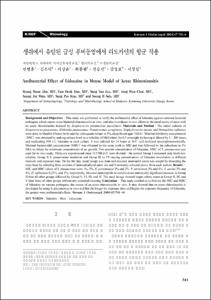KUMEL Repository
1. Journal Papers (연구논문)
1. School of Medicine (의과대학)
Dept. of Otorhinolaryngology (이비인후과학)
생쥐에서 유발된 급성 부비동염에서 리도카인의 항균 작용
- Keimyung Author(s)
- Ahn, Byung Hoon; Kim, Sang Pyo; Suh, Seong Il
- Department
- Dept. of Otorhinolaryngology (이비인후과학)
Dept. of Pathology (병리학)
Dept. of Microbiology (미생물학)
- Journal Title
- 대한이비인후과학회지
- Issued Date
- 2004
- Volume
- 47
- Issue
- 8
- Abstract
- Background and Objectives:This study was performed to verify the antibacterial effect of lidocaine against common bacterial pathogens which causes acute bacterial rhinosinusitis in vitro, and also to evaluate in vivo effects in the nasal cavity of mice with an acute rhinosinusitis induced by Streptococcus pneumoniae inoculation. Materials and Method:The initial cultures of Streptococcus pneumonia, Klebsiella pneumoniae, Pseudomonas aeruginosa, Staphylococcus aureus and Hemophilus influenza were done in Mueller-Hinton broth and the subsequent culture in 5% sheep blood agar (SBA). Minimal inhibitory concentration (MIC) was obtained by making culture broth to a turbidity of McFarland No 0.5 overnight by having it diluted by 1:200 times, and medicating 100 μL lidocaine in each culture. It was cultured for 24 hours at 36℃ and analyzed spectrophotometrically. Minimal bactericidal concentration (MBC) was obtained by the same work as MIC and was followed by the subculture in 5% SBA to obtain the minimum concentration of no growth. Two percent concentration of lidocaine, MBC of S. pneumoniae was used for in vivo study. Thirty-six experimental mice (C57BL6/J) were divided:the control Group I contained only broth inoculation, Group II S. pneumoniae inculation and Group III to VI varying concentrations of lidocaine inoculation in different intervals and exposure time. On the 6th day, nasal lavage was done and mucosal neutrophil count was sought by dissecting the mice head by selecting three sections of anatomicallynd same site and 4 randomly selected places from each section. Results: MIC and MBC values of S. pneumoniae were 1%, 2%, K. pneumoniae 2% and 2%, P. aerusinosa 2% and 4%, S. aureus 2% and 4%, H. influenzae 0.25%, and 1%, respectively. Mucosal neutorophils revealed a more statistically significant increase in Group II than all other groups followed by Group V, VI, III, and IV. The nasal lavage showed larger colony count in Group II, III, and V than those of other groups without any statistical meaning. Conclusion:This study enabled us to find out the MIC and MBC of lidocaine on various pathogens, the causes of an acute rhinosinusitis in vitro. It also showed that an acute rhinosinusitis is developed by using S. pneumoniae in vitro and that the longer the exposure time and higher the exposure frequency of lidocaine, the greater were antibacterial effects.
- Alternative Title
- Antibacterial Effect of Lidocaine in Mouse Model of Acute Rhinosinusitis
- Publisher
- School of Medicine
- Citation
- 안병훈 et al. (2004). 생쥐에서 유발된 급성 부비동염에서 리도카인의 항균 작용. 대한이비인후과학회지, 47(8), 741–746.
- Type
- Article
- ISSN
- 1225-035X
- 파일 목록
-
-
Download
 oak-bbb-03171.pdf
기타 데이터 / 2.14 MB / Adobe PDF
oak-bbb-03171.pdf
기타 데이터 / 2.14 MB / Adobe PDF
-
Items in Repository are protected by copyright, with all rights reserved, unless otherwise indicated.